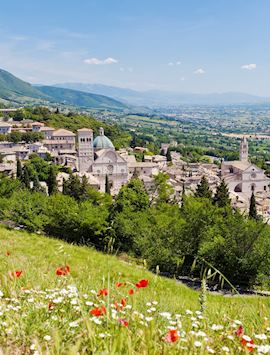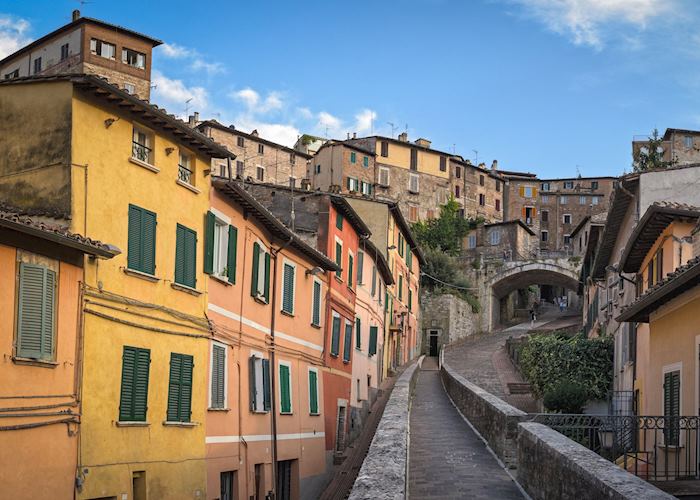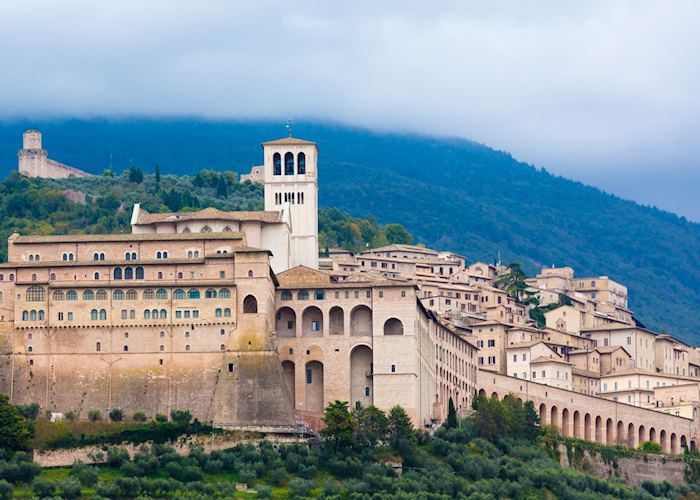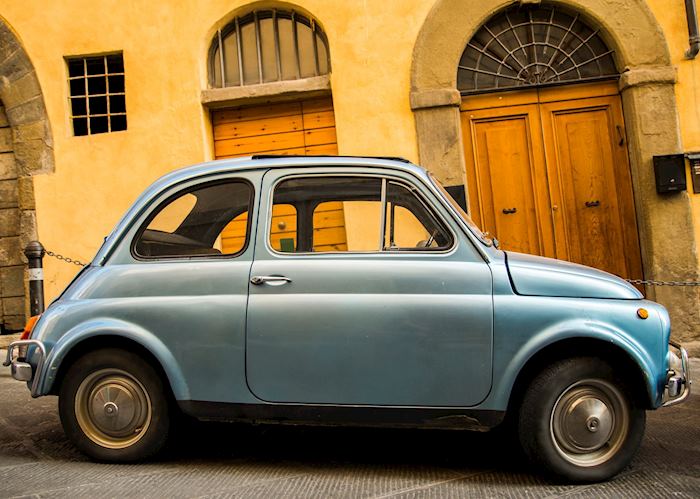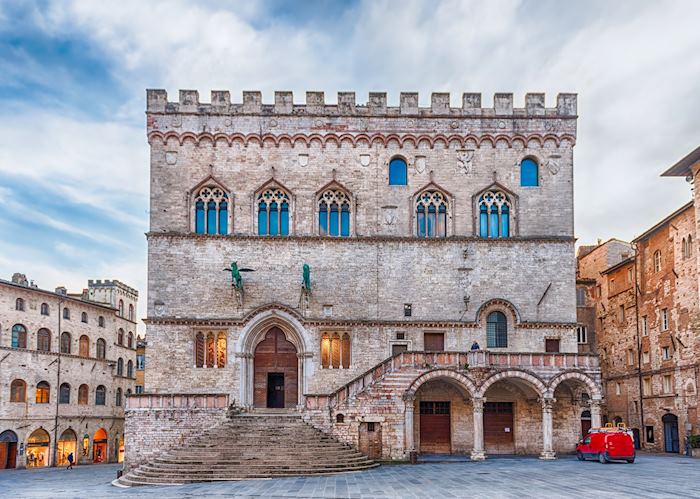Jump to:
Umbria’s provincial capital, Perugia is often overlooked, but its scenic tableau of cobbled lanes, Gothic palazzos, medieval churches and timeless arches and stairways makes it well worth a visit. The city is busy with students and locals, but has fewer visitors than Italy’s more renowned cities, yet awash with impressive architecture, and a stroll here offers a chance to explore the medieval core and see it much as it would have been 400 years ago. Perugia is also a university town and its large international student population means that the cafés, bars and restaurants are always lively. Additionally, there are annual chocolate and jazz festivals and a hidden underground city you can explore.
Things to see and do in Perugia
The centro storico
Founded by the Etruscans, Perugia later became a Roman city and later still, part of the Papal State. Vestiges of its past can be seen all over the city, from Etruscan arches and gates to ancient viaducts, medieval palazzos, Gothic churches and ornate fountains.
The city is split like a hand with five long fingers and the best way to explore is simply to meander the streets on each finger, strolling along the old viaducts, wandering down side streets and discovering hidden squares and churches. The heart of the city is Piazza IV Novembre where you’ll find the Gothic Palazzo dei Priori and the cathedral.
Piazza IV Novembre
The hub of Perugia for centuries, Piazza IV Novembre sits on the site of the city’s Roman forum. An ornate 13th-century pink-and-white marble fountain, the Fontana Maggiore, is overlooked by the medieval Cathedral of San Lorenzo which houses a Gothic interior. However, its most popular feature by far is the front steps, a popular meeting point for young and old.
Opposite is the Palazzo dei Priori, which was built in stages between the 13th and 19th centuries and is now home to the city’s municipal offices and the National Gallery of Umbria. Nearby, the extravagant Nobile Collegio del Cambio was the 15th-century seat of Perugia’s moneychanger’s guild.
The National Gallery of Umbria
Set on the upper floors of the ornate Gothic Palazzo dei Priori, the National Gallery of Umbria displays an extensive collection of medieval and Renaissance art, gold, ceramics, sculpture and frescoes. The artworks are arranged in chronological order, making it possible to trace the evolution of techniques from room to room.
Notable masterpieces include works by Piero della Francesca and Fra Angelico, with a particular focus on of local artists Pinturicchio and Perugino and their followers. The upper floor has space for temporary exhibitions that change several times a year.
Perugia’s underground city
A Renaissance fortress, the Rocca Paolina was built for Pope Paul III in the 16th century following the Salt War. Its construction destroyed Etruscan, Roman and medieval buildings, the palazzos of the ruling Baglioni family and buried former streets in the process.
A symbol of papal oppression, the fortress was pulled down in the 19th century, but it’s still possible to explore the extensive network of underground passages that were the original Etruscan and Roman streets along with vaulted chambers and the remains of ancient towers. You enter the underground city via a gleaming modern escalator, and then take another up and out to emerge into the Giardini Carducci on top of the former fortress for sweeping views of the Umbrian countryside.
Perugina chocolate
Founded in 1907, the Perugina chocolate brand is best known for its Baci chocolate kisses. The company is now based in a modern factory on the outskirts of town, and a visit to their House of Chocolate will teach you all about the history of the brand.
More interestingly perhaps, is the number of artisan chocolate producers now seen on the little streets of central Perugia. Look out for the Augusta Perusia Cioccolato e Gelateria on Via Pinturicchio for their innovative creations or linger a while in the ornate Pasticceria Sandri on Corso Vannucci with its vaulted ceilings and Liberty-style decor.
Festivals
As a university city, Perugia boasts a youthful energy year-round, but the annual jazz and chocolate festivals see the town burst into life with vibrant celebrations and throngs of visitors. The ten-day Umbria Jazz Festival is held each July across venues all over town and in the past has featured a diverse range of big international acts such as BB King, Thom Yorke and Diana Krall. In October, the cocoa bean is at the heart of the action for the free, ten-day Eurochocolate festival and its workshops, themed events, exhibitions, tasting tours and giant chocolate sculptures.
Best time to visit Perugia
A year-round destination with interest in all seasons, Perugia is perhaps at its best between April and June and in September and October when temperatures are pleasant, rainfall is low and there are fewer visitors. In July and August, temperatures can reach about 29°C (84°F), while in winter they can hover just above freezing.
who's been there
-
01993 838 92501993 838 960
- Make an enquiry
Suggested itinerary featuring Perugia
This sample itinerary will give you an idea of what is possible when you travel in Perugia, and showcases routes we know work particularly well. Treat this as inspiration, because your trip will be created uniquely by one of our specialists.
Places near Perugia
- Assisi 12 miles away
- Umbria 13 miles away
- Orvieto 31 miles away
- Siena 56 miles away
- San Gimignano 73 miles away
- Florence 73 miles away
- Rome 85 miles away
- Ravenna 91 miles away
- Pisa 109 miles away
- Bologna 110 miles away
- Forte dei Marmi 126 miles away
- Modena 129 miles away
- Porto Venere 144 miles away
- Cinque Terre 150 miles away
- Parma 156 miles away
- Venice 161 miles away
- Verona 176 miles away
- Portofino and Santa Margherita 180 miles away
- Ischia 183 miles away
- Naples 185 miles away
- Sirmione 186 miles away
- Herculaneum 189 miles away
- Lake Garda 193 miles away
- Genoa 194 miles away
- Gardone Riviera 196 miles away
- Pompeii 197 miles away
- Sorrento 201 miles away
- Capri 201 miles away
- Costa Smeralda 203 miles away
- The Amalfi Coast 206 miles away
- Milan 228 miles away
- Madonna di Campiglio 229 miles away
- Dolomites 230 miles away
- Alta Badia 242 miles away
- Barbaresco 242 miles away
- Alba 244 miles away
- Barolo 245 miles away
- Como 248 miles away
- Blevio 249 miles away
- Torno 250 miles away
- Laglio 250 miles away
- Lezzeno 252 miles away
- Bellagio 252 miles away
- Lake Como 255 miles away
- Tremezzo 255 miles away
- Piedmont 267 miles away
- Turin 270 miles away
- Stresa 271 miles away
- Lake Maggiore 271 miles away
- Sardinia 272 miles away
- Verbania 272 miles away
- Matera 275 miles away
- Puglia 291 miles away
- Alberobello 297 miles away
- Fasano 300 miles away
Photos of Perugia
Accommodation choices for Perugia
We've selected a range of accommodation options for when you visit Perugia. Our choices usually come recommended for their character, facilities and service or location. Our specialists always aim to suggest properties that match your preferences.
-
![Borgo dei Conti Resort, Perugia]()
Borgo dei Conti Resort
Perugia



